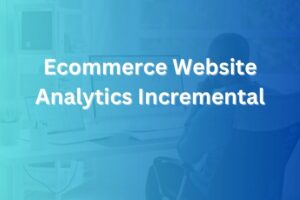

In today’s competitive digital marketplace, understanding how every click, visit, and purchase contributes to your business growth is crucial. Incremental ecommerce website analytics helps you go beyond vanity metrics and uncover the real impact of your marketing and optimization efforts.
It gives you a deeper understanding of how each campaign, channel, and customer action drives true incremental sales and revenue. In this article, you’ll learn how incremental analytics works, why it matters for ecommerce success, and how to apply it to make smarter, data-driven decisions.
Ecommerce website analytics is the process of collecting, tracking, and analyzing data from your online store to measure performance and improve business outcomes. It includes understanding traffic sources, conversion rates, average order value, customer lifetime value, and user behavior patterns. Traditional analytics provides insights into what is happening, but it doesn’t always explain why.
While basic analytics tell you how many visitors came to your site or how many completed a purchase, they don’t necessarily show whether those conversions happened because of your marketing efforts or if they would have occurred anyway. This is where incremental analytics steps in — to separate the noise from the signal.
The term “incremental” in analytics refers to measuring the additional value created by a specific marketing or business action. It helps you understand whether a campaign, ad, or website change truly influenced a customer’s decision to buy or if the purchase would have happened regardless.
For example, if you run a paid ad campaign and notice a 20% increase in sales, incremental analysis helps determine what portion of that 20% was directly driven by the campaign versus what would have occurred naturally. This distinction is vital for making informed decisions about where to allocate your marketing budget effectively.
In ecommerce, it’s easy to spend money on ads and promotions that seem effective on the surface but may not actually contribute incremental value. Incremental analytics helps you uncover the true return on investment by distinguishing correlation from causation.
Here’s why it matters:
When analyzing ecommerce performance with an incremental lens, several core metrics matter most:
Many ecommerce businesses rely on attribution models like first-click, last-click, or linear attribution to credit conversions. However, these models don’t always capture true incremental impact.
For instance, if someone clicks your Google ad but later returns to your website directly to buy, a last-click model might credit the conversion to the direct visit. Incremental analytics uses control groups, experiments, and predictive modeling to understand whether the ad truly influenced the customer’s purchase — giving you a more reliable picture of what’s driving growth.
Implementing incremental analytics involves a structured approach that combines testing, tracking, and interpretation.
Data integration plays a crucial role in ensuring accuracy. Ecommerce businesses often gather data from multiple channels — ads, email marketing, social media, and CRM systems. Without unifying these sources, measuring incremental impact can be misleading.
A single customer may interact with your brand through several touchpoints before purchasing. Integrating data allows you to connect these dots and understand the full customer journey. Modern data warehouses like BigQuery or Snowflake make it easier to merge and analyze large volumes of data efficiently.
With advances in AI and machine learning, ecommerce businesses can now predict incremental outcomes with higher accuracy. Algorithms can detect hidden patterns in user behavior, helping you anticipate what marketing actions will generate the highest incremental lift.
Predictive models can also simulate different budget scenarios, allowing you to test which mix of channels delivers the best incremental ROI without wasting real-world spend. As ecommerce competition grows, leveraging AI-driven incremental analytics is becoming a critical edge for data-savvy retailers.
Let’s say you run an email promotion offering 10% off to repeat customers. After analyzing performance, you find that half of those who purchased would have bought anyway — meaning your true incremental lift was only 50%.
Similarly, if you test two ad campaigns, one targeting new users and one retargeting past visitors, incremental analytics might reveal that the new-user campaign generated 70% more incremental revenue. Such insights help you refine targeting strategies and reduce wasted ad spend.
While incremental analytics offers significant benefits, it’s not without challenges. Setting up control groups and experiments can be complex. Many external factors — seasonality, competitor activity, or economic shifts — can influence results.
To overcome these challenges, use long-term testing and multiple experiments to establish reliable baselines. Combine incremental analysis with ongoing performance monitoring to ensure accuracy and consistency across campaigns.
Once you have a clear understanding of incremental impact, you can apply it across your business strategy:
By aligning incremental analytics with your overall ecommerce strategy, you create a data-driven growth engine that ensures every dollar spent delivers measurable value.
As privacy regulations evolve and third-party cookies phase out, incremental analytics becomes even more valuable. Instead of relying on traditional attribution, businesses can use incrementality testing to understand the real effects of marketing without invasive tracking.
The future lies in predictive incrementality — where machine learning models automatically suggest which campaigns are likely to drive the next wave of growth. For ecommerce brands in the U.S. and beyond, adopting incremental analytics today sets the foundation for a smarter, more profitable future.
Ecommerce website analytics incremental is more than just a buzzword — it’s a shift in how you measure success. By focusing on true cause-and-effect relationships, you can eliminate wasted spend, sharpen marketing strategy, and achieve sustainable growth.
With the right tools, mindset, and continuous experimentation, you’ll uncover what truly drives your business forward. Embrace incremental analytics, and you’ll transform raw data into actionable insights that propel your ecommerce store to long-term success.
Showcase your skills, projects, and agency with Portlu—a modern, customizable HTML5 template designed for creative professionals.